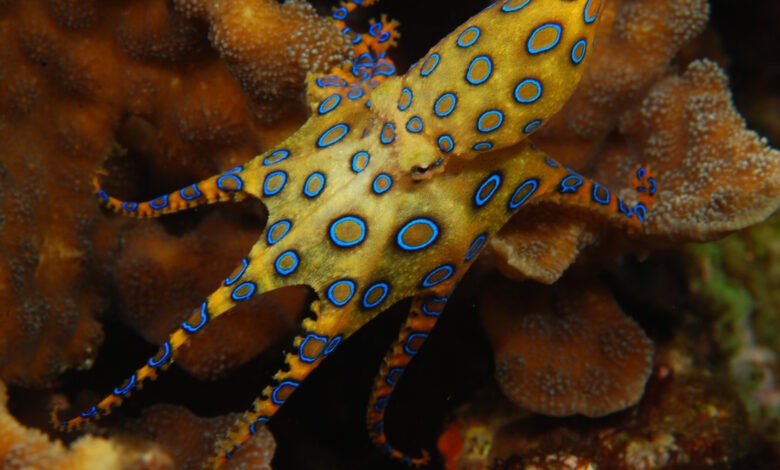Octopus inspired camouflage

A chameleon of the marine world, the blue ringed octopuses are known for their ability to change the color and size of the ringed patterns on their body almost instantaneously, enabling it to lure prey as well as camouflage itself from predators.
Taking inspiration from this marine wonder, researchers at the University of California in the US have developed a technological platform with similar capabilities, which could find use in a variety of fields including, military, medicine, robotics and sustainable energy.
The properties of this innovative invention, such as its dynamically adjustable fluorescent and spectroscopic aspects, as well as its ease of manufacturing, and potential for scaling to larger areas. The device could be adapted in the future to design of products that require camouflage or signaling capabilities, including military equipment, vehicles, uniforms and other fabrics. It could be used by advertisers on billboards, or by designers and architects to improve aesthetic and protective features of entire buildings, or find use in more traditional equipment such as LED bulbs and to improve efficiency of solar panels.
The Greater Blue-ringed octopus (Hapalochlaena lunulata) is a species of octopus native to tide-pools and coral reefs along the Western Pacific Ocean and Indian Ocean. They can be identified by their yellowish skin and characteristic blue and blackish-brown rings that can change color when the animal is threatened or attract prey with its flash of blue rings.
Although relatively small in size, this species is one of the most venomous marine animals in the world, with their venom loaded with tetrodotoxin, a powerful neurotoxin that causes destruction of nerve tissues stunning and killing prey.
H. lunulata achieves its camouflaging capabilities from millions of tiny organs called chromatophores containing specific dyes on their skin that can be expanded or contracted using a network of tiny skin muscles. The motion of the muscles allows the octopuses to change the shape of the chromatophores, to repaint their skin in less than a second.
Underneath the top layer of H. lunulata skin is a second skin layer which harbors cells called iridophores that are rich in slabs of protein that behave like reflectors. The skin’s bottom layer is a carpet of white cells, or leucophores, which form a bright canvas on which the color from the two upper layers can stand out.
For their project, the researchers worked to mimic the natural abilities of H. lunulata by developing a device from unique materials specifically synthesized in their lab. The result was a camouflaging and signaling system that is straightforward to fabricate, functions for a long time when operated continuously, and can even repair itself when damaged.
The unique capabilities of the new device came from a thin film of nonacene-like molecules similar to the organic compounds called acenes, The film was made up of linearly fused wrinkled blue rings around a flatter brown circle above an acrylic membrane, and the two layers sandwiched between a top and bottom layer of transparent proton conducting polymer electrodes.
Acenes are organic hydrocarbon molecules with a host of advantageous characteristics, including ease of synthesis, adjustable electronic characteristics, and controllable optical properties.The synthesized acene-like molecules were also exceptional in that they can survive years of storage in air, and last for over a day of continuous irradiation with bright light.
In their laboratory tests, the team found that the bioinspired devices could change its visible appearance over 500 times with little or no degradation, and they also could autonomously self-repair without user intervention. Additionally, it possessed a desirable combination of capabilities in the ultraviolet, visible light, and near-infrared parts of the electromagnetic spectrum. This would enable the devices to disguise other objects from detection or to clandestinely signal observers.













